Solar electricity is something of a paradox: it is by far the most expensive means by which we humans generate electricity, yet is it one of the most popular choices of the poorest people in the poorest nations, for example, residents in remote villages in India.
The reason for this is simple: although solar electricity costs quite a lot, in rural areas in less developed countries it’s cheaper to install solar electric panels than to string electric lines to villages hundreds of miles from central power plants.
Far cheaper.
Solar electricity is also much cheaper than conventional electricity in certain areas in the United States, For example, when building a new home more than a couple tenths of a mile away from a power line it is often cheaper to install a solar system — especially if your home is energy efficient and the local utility won’t foot the bill for grid connection. Contact your local utility to determine their line extension policy and pricing. Some companies don’t charge much to connect.
If you are building a home more than half a mile from a power line, it often makes more sense to install a solar electric system than to connect to grid power. Although some local utilities have generous line extension policies, many typically charge $50,000 or more to run a line to your home if you’re a half mile from the electric line, That $50,000 investment to hook up your home to the grid will buy you an enormous solar system, nearly double what you will need, Moreover, the fee to connect to the grid doesn’t pay for a penny’s worth of electricity It just gets you utility poles, an electric line, a meter, and a connection to the grid. You be charged for electricity on top of the hookup fee. In contrast, a $25,000 to $50,000 solar electric system provides you a lifetime of electricity (although you will need to replace batteries every 7 to 15 years, depending on how you maintain them).
Solar electric systems also make sense in states or countries in which electrical costs are extremely high. In California and Germany, for instance, conventionally produced electricity goes for premium prices. Solar electric systems also often make sense in states in which utilities offer generous financial incentives to install them, In California, for example, customers can receive rebates from various local and state agencies, totaling about half the cost of the system. Such generous incentives dramatically reduce the cost of solar electricity, driving it down to about 12 cents per kilowatt hour. By the way, Californians are currently paying about 30 cents a kilowatt hour for electricity from the grid.
Illinois also offers generous incentives totaling about 50 percent of the cost of a solar electric system. New York State provides a 25 percent tax credit. The state of Florida currently exempts solar electric systems fro certain taxes, and some areas like Colorado’s Roaring Fork Valley, home to the prosperous town of Aspen, offer zero-interest loans for homeowners who install solar electric systems.
If you live in a state like Arizona, Illinois, New York, Colorado, or New Jersey, or are served by a progressive utility that offers generous financial incentives that slash the initial costs of a solar electric system, you may want to do it right now. (We predict that many states and local utilities will be offering rebates as the energy picture becomes more grim.) To determine whether you are qualified to receive a rebate, call your local utility. Better yet, check out incentives on the Database for State Incentives for Renewable Energy Incentives.
But what if there aren’t any incentives available in your area?
You may want to install a solar electric sys tem as a hedge against rising prices. Or you may, like me, want to install a system to achieve energy independence and reduce your environmental impact. Because solar systems can be expanded, you may simply want to invest in a few panels at a time and build your system over a period of five to ten years.
WHAT IS A SOLAR ELECTRIC SYSTEM?
Solar electric systems fall into three main categories: grid-connected, grid-connected with battery backup, and stand-alone, a distinction that will become clear shortly. ___s below show all three options and their main components.
Grid-Connected PV Systems
To gain a deeper understanding of the anatomy of solar electric systems, we will begin with the grid-connected system, the simplest of all three. We begin with a basic schematic, shown in ___ below, As you can see, this sys tem consists of three main parts: a solar module, an inverter, and the main service panel. Let’s begin with the solar array.
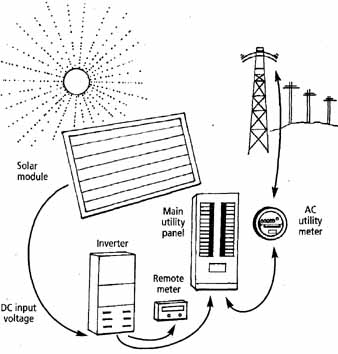
The anatomy of a grid-connected solar electric system.
Like all other solar systems, the grid- connected system consists of one or more solar electric modules also known as photovoltaic or PV modules (___ above). Each solar module consists of numerous smaller solar cells, usually round, square, or rectangular cells about 1/100th of an inch thick and made from silicon dioxide (___ a below). Silicon dioxide comes from a highly ubiquitous material, high-grade sand, and quartz rock, The solar cells most widely used today typically consist of two thin layers of silicon, As illustrated in ___ b, each cell in a module has numerous thin metal electrical connections (metal contacts) on the surface that gather up electricity generated by the cell.
A solar or photovoltaic cell is a solid state device that absorbs visible light and converts its energy to electricity. How that works is fascinating, but beyond the scope of this guide, Suffice it to say that when sunlight strikes a PV cell it liberates electrons from silicon atoms, Thanks to some ingenious chemistry (boron and phosphorus are added to different layers of the PV cell), these electrons are forced to migrate from one side of the cell to the other, where they are drawn away by the metal contacts on the cell’s surface, as shown in ___ b. Flowing electrons form an electrical current,
Because silicon reflects about 35 percent of the light striking it, the cells are coated with a thin, anti-reflective layer of silicon monoxide or titanium dioxide; it is applied after the metal contacts have been put in place. The back of the cell is made of a thin layer of metal that completes the electrical circuit, as shown in ___ below.
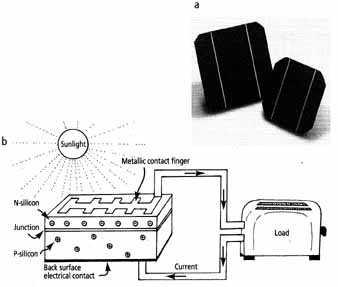
(a) Two solar cells. (b) Note that solar cells consist
of two layers. Light striking the layers liberates electrons from the
silicon atoms. These atoms flow from the deeper layer to the more superficial
layer and then are drawn off by the metal contacts on the surface, creating
direct current electricity.
Silicon cells are mounted in the metal- backed module casing and wired in series to boost the voltage. The unit is sealed by a clear layer of glass or, in some cases, durable sun- resistant plastic. Glass and plastic prevent moisture from reaching the cells and also resist the pounding force of hail stones. Typical modules produce between 40 and 200 watts of electrical power under peak sunlight conditions, although some manufacturers are producing larger modules that produce 300 watts. Numerous modules together form a solar array.
PV modules are typically mounted on a durable metal rack. The rack may be located on a roof of home or on the ground in a sunny location with good access to the sun year round. In some installations, the modules are mounted on a rack attached to a pole. In others, the racks are part of a more elaborate tracking device that enables the panels to follow the sun from sunrise to sunset each day. (Be sure to install your solar electric panels so they are out of the reach of vandals or livestock.)
Solar arrays produce direct current (DC) electricity when the cells are struck by sun light. Direct current electricity consists of electrons flowing in wires in a single, fixed direction. The energy they contain can be used to power motors, lights, home appliances, and a host of other electronic devices.
The DC electricity produced by a solar array is carried away by wires that lead into the home. As you may know, however, virtually all of our homes use another type of electricity, known as alternating current (AC). AC electricity consists of electrons that cycle very rapidly back and forth through a wire. In North America, standard household current is 60 hertz, or 60 cycles per second. That means that in standard household electrical current, the electrons cycle back and forth 60 times per second. The energy these electrons carry is used to power a wide range of 120- and 240-volt appliances and electronic devices in our homes.
In order for the DC current produced by PV cells to power our homes, then, it must be converted into AC current. This task is relegated to a component of the solar electric system known as an inverter, shown below. The inverter converts DC electricity into AC electricity. It also boosts the voltage from 12, 24, or 48 volts to 120 volts or 240 volts (for some appliances like electric clothes dryers). The 120-volt or 240-volt AC current then travels to the main electrical service box of your home which routes the electricity to the circuits in your home.
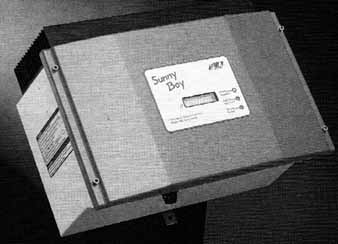
Inverter. This quiet, efficient inverter by Sunny Boy
converts direct current produced by PVs (or a wind generator) into alternating
current and boosts the voltage to 120. lnverters that are used in systems
with batteries typically contain battery chargers.
In grid-connected systems, electricity from the solar array powers a wide range of devices. Excess electricity is diverted automatically into the electrical grid. Surplus power simply flows out through the main service panel to the electrical wires that connect your home to the grid.
In many grid-connected solar electric systems, electricity flowing to the grid runs through the very same meter that keeps track of electricity delivered to your home from the grid. Electricity you are sending to the grid, however, runs the meter backwards, so you are credited for the electricity you supplying to the grid. (More on this shortly.)
Additional Components: Meters and Disconnects
AC Devices Run on DC Even though we plug all electronic devices and appliances into wall sockets that deliver alternating current, many of them actually run on DC current. The small black transformer of a laptop computer, for instance, converts the AC to DC and decreases the voltage. |
All code-compliant solar systems include two additional components: meters and disconnect switches, Meters are used to measure electrical production and consumption. The meters that measure electrical production by a PV sys tem and consumption by you and your family at any given time, providing an instantaneous picture of energy production and consumption. They are typically located on the inverter itself or in a separate location, situated in a convenient place for ease of monitoring.
Meters typically track electrical production and consumption in amps or amperes. More sophisticated meters, however, measure long-term electrical production — that is, the total energy produced and consumed over long periods of time. As a result, they typically keep track of production and consumption in kilowatt hours.
If an inverter doesn’t come with a built- in meter, you can buy a separate unit and connect it to your system.
Grid-connected PV systems also require one sometimes two — standard utility electrical meters. These large, tamper-proof glass-encased meters are installed by the utility company. They keep track of monthly energy production and consumption so the utility can bill you at the end of each month.
Grid-connected solar electric systems also contain a couple of safety switches, called disconnects, Disconnects enable homeowners or service personnel to shut power down to prevent electrical shock when working on the system.
As shown in the illustration below, a DC disconnect is located between the solar array and the inverter, It is used to terminate the flow of electricity to the inverter, The other disconnect, the utility-accessible AC disconnect, is located between the inverter and main service panel. It is used to shut off the flow of electricity from the inverter to the household circuits and the grid. The AC disconnect is a safety switch utility workers shut off if they need to work on the electric lines to your home or in the neighborhood.
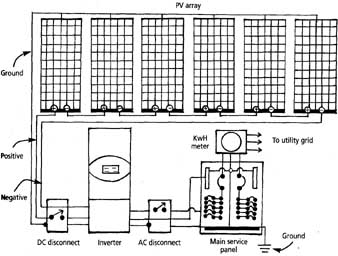
This schematic shows all of the components of a grid-connected
solar electric system, including charge controllers and disconnects.
How Utilities Meter Electricity in Grid- Connected Systems
Before we explore the two other types of solar systems, let’s take a moment to see how a grid-connected system works. Let’s also see how utilities keep track of electrical production and consumption.
Unlike stand-alone systems, grid-connected PV systems have no physical on-site electrical storage capacity. That is, they have no means of storing electricity for later use, for example, at night when the PV modules are inactive, Solar homeowners, however, use the electrical grid as their “storage battery”. That is to say, the electrical grid accepts excess electricity when a solar electric system is producing more electricity than a home is using. Excess electricity that’s transferred onto the grid is used by one’s neighbors. At night, when a system is no longer producing electricity — or during the day when a home requires more electricity than the PV system is producing — electricity is drawn from the grid.
To keep track of this, many utilities simplify matters by installing one electrical meter. It contains a flat disk that runs forward when electricity is being drawn from the grid.
Each rotation of the disk represents a certain amount of electricity consumed by a house hold. Rotations of the disk are converted to kilowatt hours by the meter.
When electricity is flowing on to the grid, the meter runs backwards subtracting from the amount of electricity your home has consumed previously. The kilowatt-hour reading on the meter decreases.
This simple arrangement is called net metering. What it means to you, the producer and consumer of utility power, is that you are charged for net electrical usage (production of electricity — consumption = net use).
More on Net Metering To view some frequently asked questions on net metering, you can log on to this website sponsored by Home Power magazine, a leader in home renewable energy. |
If, at the end of the month, your system has delivered 400 kilowatt hours of electricity to the grid and your household consumed 400 kilowatt hours at night, your cost will be zero although the utility will very likely charge you a fee (around $10 - $20 per month) to read the meter, If your system delivers 800 kilowatt hours of electricity during a month, but only draws 600 kilowatt hours of electrical power from the grid, you won be charged for any electricity. But don expect a check for the excess you sold to the utility. From the research I’ve done, utilities generally don’t reimburse customers for surpluses. They may credit it to offset future bills when customers consume more electricity than they produce.
As of December 2004, 23 states had net metering laws in place requiring utilities to credit customers for the electricity they deliver to the utilities at the same rate they charge for the electricity they deliver to a home. See the sidebar for a website that will help you deter mine if the state you live in requires utilities to use net metering.
In states where net metering is not required by law, utilities can make the lives of those with grid-connected PV systems rather difficult. They typically require the installation of two electric meters on houses, one to measure how much electricity is deliver to the grid, and another to determine how much the customer buys from them. This allows the utility to monitor the electricity they sell to the homeowner, for which they charge the full retail price, usually around eight to ten cents per kilowatt hour. The second meter in the system allows the utility to monitor the electricity customers “sell” to them. By law, however, the utility is only required to pay what it costs them to generate electricity, usually only two to three cents per kilowatt hour. In addition, solar home owners will very likely also have to pay for the second meter, and the utility may charge more to read two meters.
To understand how this works, let’s sup pose that you consume 400 kilowatt hours of electricity from the grid one month but generate twice as much, 800 kilowatt hours of surplus electricity, that you deliver to the grid. How much will the utility charge you?
Under this plan, the utility will charge you $32 for the 400 kilowatt hours of electricity that you purchased from them (400 kwh x 8 cents per kwh) plus a fee to read your meter. However, they will only credit your account $16.00 (800 kwh x 2 cents per kwh = $16.00). You’ll owe them $16 plus a meter reading fee of $10 to $20. You lose; they win.
Had your home been in an area that per mitted net metering, the utility would have credited you for the excess, in other words, you would have been $36 dollars ahead of the game, minus a meter-reading and billing fee,
Grid-Connected Systems with Battery Backup
Some homeowners elect to install batteries in their grid-connected systems to provide backup power in case grid power goes down, for example, if a tree branch falls on a utility line and shuts down the electrical power system supplying you and 65 million other people. A typical grid-connected system with batteries is shown below.
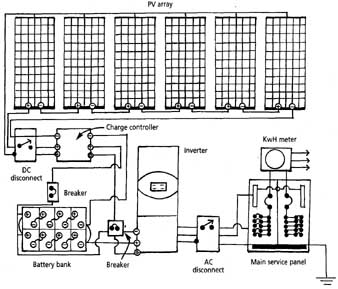
This schematic shows all of the components of a grid-connected
solar electric system with a battery bank to store back-up electricity.
Note the presence of controllers and disconnects whose functions are explained
in the text.
Checking Your Batteries Most sophisticated solar electric homeowners monitor battery performance with an ampere-hour meter. Besides supplying information on battery voltage, this device keeps track of how many amp-hours of electricity are stored in the battery bank at any one time. They also typically monitor how many amps are going into and how many are being drawn from the batteries at any given point in time. |
In grid-connected systems equipped with battery banks for backup power, the solar array produces electricity that feeds live circuits in the house during the day. Excess electricity is stored in the batteries. When the batteries are full, excess electricity is diverted onto the electrical grid. At night, power required for household use is typically delivered by the grid. The batteries are called into action only when grid power fails, (Batteries can also be charged by grid power when voltage runs low.)
A grid-connected system with battery backup includes all of the components of a grid-connected system, including disconnects for safety. Grid-connected solar electric systems with battery backup, however, also require an additional component, one we haven’t discussed yet. That is a charge controller, as shown in the schematic in ___ above.
Charge controllers are electrical devices that monitor battery voltage and then utilize the information to protect the batteries. The charge controller is typically housed in a metal box that is mounted on the wall near the inverter next to the DC safety disconnect.
The charge controller protects batteries against overcharging and is also known as a high-voltage disconnector. When the device detects high battery voltage, indicating batteries are full and in danger of overcharging, the charge controller interrupts the flow of electricity from the PV array into the batteries, protecting them from overcharging. Overcharging can damage the metal plates in batteries, reducing battery life,
Grid-connected systems with battery backup also contain meters to monitor electrical production and consumption and battery voltage. Battery voltage provides a measure of the state of charge of a battery bank — that is, how much electricity batteries are holding at any one time. Other more sophisticated ways to keep track of your batteries are discussed in the accompanying sidebar,
Stand-Alone Systems
Next on our list is the stand-alone system. The ___ below is a schematic of a stand-alone solar electric system. As you can see, it is very similar to the grid-connected system with battery backup. You will notice two distinct differences, however. First, there is no connection to the grid. Thus, no power is shunted to the utility grid. This system, which must have batteries, “stands alone”. Second, this system usually includes a backup generator. It can be run to charge the batteries when they run low. Some people install wind turbines to serve as a second charging source, according to the Director of Solar Energy International.
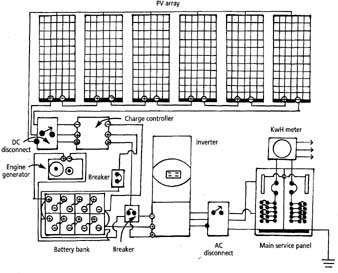
This schematic shows all the components of a stand-alone
solar electric system including charge controllers and disconnects.
As illustrated in the ___, the main power source of a stand-alone system is the PV array. Electricity flowing from the array into the house first travels to the charge controller, then to the batteries. When electricity is needed in a home or office, it is drawn from the batteries. DC flows from the batteries to the inverter. The inverter converts the low-voltage DC solar electricity to high-voltage AC current, It is then delivered to open (active) circuits in the house via the main service panel.
If the batteries are full, the system merely shuts down temporarily so the batteries don’t overcharge and fry. This task is managed by the charge controller with its high-voltage disconnect.
Stand-alone systems shunt additional power into the batteries during daylight hours for use at night. But batteries can also be called into duty during the day, for example, when clouds block the sun.
Like other solar electric systems, stand alone systems require a couple of disconnects, to enable you or a repairman to service your system without being electrocuted,
Stand-alone solar electric systems like the one shown in ___ above also include another charge controller, known as a low-voltage disconnect, That outwardly simple box monitors battery voltage. When it senses low voltage, the low-voltage disconnect temporarily terminates the flow of electricity from the batteries to the inverter. This prevents over- discharging that is, draining the batteries too far, Over-discharging can permanently damage a battery bank.
Power Centers
Stand-alone solar electric systems can seem pretty complex with enough connections to frustrate the far more complex neuronal path ways in the human brain, There is, however, a way to avoid some of the confusion: install a power center (see image below).
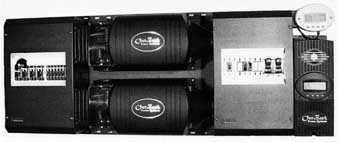
For stand alone systems, the power center is a helpful
organizer of components. It contains meters, charge controllers, and disconnects.
A power center is the grand central station of a stand-alone solar electric system. All of the components of the system connect here, For example, there are busses (connection points) to which the electrical wires leading to the battery bank, the inverter, and the solar array all connect, The power center houses the disconnects, the charge controllers, and the meters required by a system, too, making it relatively easy for someone with a few million functional brain cells to hook up a system.
We love our power center and strongly recommend that you consider one, too, if you are going to install a stand-alone system It may cost you a bit more than buying the components separately, but it is well worth it when you take into account the reductions in cerebral hemorrhaging that will result from attempts to buy all of the components separately and wire them in some meaningful and functional manner that meets all of the safety requirements of the National Electrical Code.
Another good reason to consider buying a power center is that they are very popular among electrical inspectors who typically know very little about solar electric systems. When an inspector sees a power center, he or she knows that all of the essential safety circuitry and all of the vital components required in a solar electric system are present and accounted for, housed as it were within that outwardly simple box. Rather than have to go through the system with a fine-toothed comb, they’ll take one look at your system, find the UL (Underwriter’s Laboratory) sticker, and then check it off on their inspection sheet and move on to their next home inspection.
DC Circuits
So far, the discussion of solar electric systems has focused on converting the DC power they produce into the AC power used in our homes. We’d be remiss to leave the discussion there. Solar electric systems can be designed to use DC power directly for all circuits or a few, In my home, for instance, we run a small DC electric pump to pump water from our cistern to the house, This pump uses 24-volt DC current.
We did this for one simpler to bypass the inverter both to save energy and to simplify the system. How does bypassing the inverter save energy.
Inverters consume energy when they’re operating. For example, when my inverter converts 24-volt DC electricity from my batteries to 120-volt AC current, it loses about 10 percent of the energy that goes through it. By bypassing the inverter with a DC circuit to the water pump, I raise the efficiency of my system.
Other appliances and consumer electronics can also be run on DC power. For example, SunFrost refrigerators, which are one of the most efficient refrigerators on the market today, can be ordered with DC components at no extra cost. Because refrigerators account for about one tenth of your daily electrical consumption, you can save substantially by purchasing a DC refrigerator and bypassing the inverter.
Ceiling fans can also be ordered in DC models. Here, though, you need to think carefully. I was planning on doing this until I found out that DC ceiling fans cost $200 each, compared to $40 each for standard AC ceiling fans. I couldn’t justify spending $480 more for three ceiling fans to bypass the inverter.
Many other DC appliances are available, but they tend to cost more and are typically designed for use in RVs or cabins. They’re not ideal for household use, unless you’ve pared down your demands.
As a rule, then, DC circuits aren’t of much value in most homes. But don’t close the book on them. Johnny Weiss recommends installation of at least one DC circuit to power a light bulb in the utility room (where the inverter is located) in case of emergency.
Which System is Best for Me?
As you have just seen, you’ve got three choices when it comes to installing a solar electric sys tem. You can install a grid-connected system, which is by far your cheapest and easiest option. Or you can install a grid-connected system with a battery bank. Or you can go off-grid entirely, by installing a stand-alone system.
When consulting on this matter, I suggest that clients start simple with a grid-connected system. Use the grid as your battery bank and suffer through power outages like the rest of us, Or install a battery bank for backup, and invite your neighbors to stay with you when grid power crashes.
Using the grid as a battery bank obviously poses potential problems. Most notably, it is going to cost you some money. In new construction, for example, you’ll have to pay to run electrical lines to your home and to install a meter or two. (When I was building my home, the local utility wanted about $2,000 to run an electrical line to my house from the buried electrical line near the road 150 feet away from the house and to install a meter.)
In new and existing homes, you will also very likely be required to install a safety switch (an AC disconnect) so firefighters can shut your solar system off in case of a fire or so that utility company employees can shut off your system if they’re working on the lines in the neighborhood. (They don’t want electricity flowing onto the grid from your system while they’re working on nearby lines for fear of electrocution. What some building code officials don’t seem to realize or accept is that modern inverters automatically terminate the flow of electricity from solar electric homes when they sense a drop in line voltage in the grid.)
If you are installing a system on an existing home, be sure to contact the local utility company and inform them of your plans. You’ll need to work out an arrangement with the company: either a single-meter net metering deal or a more cumbersome two-meter system, where they pay you for the electricity they buy from you at a discounted rate.
Despite these problems, grid-connected systems have some serious advantages. They eliminate costly batteries. A single battery bank may contain one to two dozen batteries costing $200 to $300 each, The battery bank needs a home, too, that is, some safe place where batteries can be kept warm but not hot, That’s because the lead acid batteries typically used in solar electric systems function optimally at around 70°F (21°C).
Many people house their batteries in sheds or in garages, often inside a sealed battery box, The battery room or battery box needs to be vented to the outside so that hydrogen gas produced when batteries are charging can be safely vented outdoors. (Hydrogen is explosive at certain concentrations.) Building a battery box and a place to keep it costs money. and don forget that your battery bank needs to be wired into your solar electric system, which also requires a bit of money. in addition, batteries require periodic maintenance that is going to take some time on your part (battery maintenance is discussed below).
Optimistically, lead acid batteries only last five to ten years, according to Weiss, depending on how you take care of them, and how heavily you draw on them. Replacing batteries costs money.
In sum, then, even though a grid-connected system may cost you a bit more upfront when building a new home (to hook up to the grid and install meters) and may cost you a bit each month (for meter reading), it will avoid hefty battery costs, As such, it is usually cheaper to install a grid-connected solar electric system (provided you live near the grid). You may grumble about the monthly meter reading bills and the fact that the utility doesn’t pay retail rates for the surplus you generate, but remember how much your batteries would have cost you and how much you would have spent replacing them every five to ten years.
A Few More Considerations: Battery Maintenance
Before you make up your mind what kind of solar system you want, you should consider system maintenance. A grid-connected sys tem is virtually maintenance-free. If you live in a dry dusty area or a polluted city, you may need to periodically clean your PV modules; for example, you may need to wipe or rinse dust off your modules from time to time. In most locations, however, rain does the job free of charge. (I’ve never cleaned mine and we only get about 20 inches of precipitation per year.)
In snowy climates, you may also need to periodically sweep snow off your array, being careful not to damage the modules, Even a tiny amount of snow blocking the bottom of a PV panel can reduce its power production by more than 90 percent, although several manufacturers (like Sharp) have produced modules that minimize the power drop caused by shade (they’ve installed bypass diodes in their modules). If you live in a snowy climate, be sure to install PVs in a place that’s easy to reach so you can remove snow easily.
Reducing Battery Maintenance When batteries are being charged, they give off hydrogen and oxygen, both gases derived from the breakdown of water. (Electricity passing through water breaks it down into hydrogen and oxygen. Thus some of the recharging energy is being wasted by splitting water molecules, a process called electrolysis.) Hydrogen and oxygen enter the catalyst-filled reservoir in the Hydrocap where they recombine to form water. It drips back down into the battery. This not only reduces watering, but reduces the danger of hydrogen gas emissions from battery banks. |
Stand-alone solar electric systems are a bit more complicated than grid-connected systems and require a lot more maintenance. Why do we recommend against them?
As noted earlier, lead acid batteries used in stand-alone systems require babying. Batteries function optimally at 70°F (21°C). At higher or lower temperatures, their performance plummets. To ensure optimal performance and long life, you need to be certain that you have a location to house batteries at their preferred temperature.
Batteries also naturally lose water when being charged; either by electricity from the PV panels or the generator. To keep the lead plates from drying out, which can ruin them, you will need to periodically refill your batteries, one cell at a time, with distilled (de-ionized) water. Batteries should be checked every month and topped off if necessary (be sure not to overfill), according to Richard Perez who publishes Home Power magazine. Refilling takes a half-hour or so, depending on the size of your battery bank and how accessible the batteries are.
To reduce water loss and battery maintenance, two companies have produced special battery caps: Hydrocaps and Water Miser caps. Both caps are designed to replace standard cell caps that come with lead acid batteries.
Hydrocaps contain a small catalyst-filled reservoir (see image). The platinum catalyst converts hydrogen and oxygen released by batteries when being charged into water (see sidebar for explanation). Hydrocaps reduce water losses by around 90 percent. (As noted in the sidebar, you can also install automatic and manual battery filling systems to reduce battery maintenance.)
Water Miser caps can also be used, but they reduce water loss by only 30 to 75 per cent. They also function differently. Rather than trapping hydrogen and oxygen and converting it back to water, Water Miser caps trap water vapor and fine acid particles evaporating from the battery fluid. Water and acid drip back into the batteries. Of the two, I prefer Hydrocaps. They cost more than Water Miser caps but do a better job at reducing water losses.
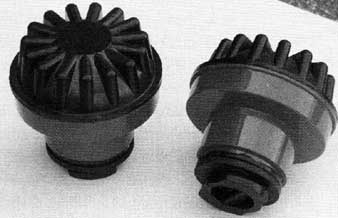
Hydrocaps. These battery caps replace standard caps that
come with lead acid batteries. The catalyst in the reservoir captures
hydrogen and oxygen given off by the breakdown of water arid recombines
them, reducing water loss by 90 percent, thus cutting down on routine
maintenance.
Another way to reduce maintenance is to install a battery filling system, shown in image below. Battery filling systems automatically fill batteries from a central reservoir filled with distilled water, totally eliminating this time-consuming chore, Battery filling systems consist of a series of plastic tubes connected to a central reservoir in the battery room, Each battery cell is fitted with a special cap equipped with a float valve, When the water level drops in a cell (there are usually three cells per battery), the valve opens and allows enough water to fill the battery to the proper level. Unfortunately, the unit costs about $16 per cell or $48 per battery. A battery bank with 12 batteries would cost $575.
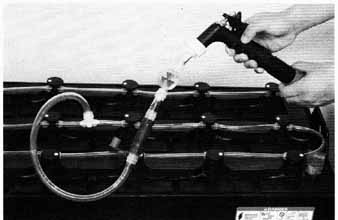
Battery Filling System. This product is designed
for those who don’t want to have to top off their batteries every three
or four months. Float valves in the caps tell when a cell needs replenishment.
Distilled water flows into the cells from a central reservoir (not shown
here).
Another disadvantage of the stand-alone system is that batteries need to be equalized from time to time — usually, every three or four months. Equalization is a controlled overcharge of the batteries. Batteries are typically equalized by running a generator. The process is pretty simple: to equalize batteries, a homeowner starts up the generator (which is connected to the inverter/battery charger) then flips on the circuit breaker in the line connecting the generator to the inverter/battery charger. At this point, the inverter/ battery charger takes over, When equalizing batteries, electricity is fed into the battery bank very rapidly at first, As the batteries are charged, however, the flow of electricity gradually slows. At the end of the process, electrical current trickles into the batteries. When the batteries are fully charged and equalized, the inverter shuts off, and you done.
Equalization achieves two important goals. It raises the voltage of each cell to the same level for optimal function, hence the name equalization. (A battery bank performs only as well as the lowest-voltage cell in the array.)
Equalization also cleans the plates in your batteries; that is, it drives the lead sulfate off your plates. Lead sulfate forms on the lead plates of batteries when they discharge — that is, give off electricity. (For those who know a bit about batteries and lead acid battery chemistry: lead sulfate forms on the lead plates that feed into the anode [ negatively charged pole] as well as those that feed into the cathode [ positively charged pole]).
Lead sulfate accumulating on the plates inside a battery reduces the amount of electricity a battery can store, greatly hindering a system. Periodic equalization helps restore the batteries and increases their lifespan.
FYI: Making Sense of Generators
Stand-alone systems typically require a generator for backup power, but also to perform routine battery maintenance, notably periodic equalization. How often homeowners need to run a generator depends on many factors, among them the size of the PV system, house hold energy use, and the amount of available sunshine.
Generators are expensive and burn costly fossil fuels (gasoline, diesel, propane, or natural gas). They’re also prone to breakdown and many models are quite noisy. In addition, some units may not last more than 500 hours, according to some sources. Because of these factors, we recommend that homeowners oversize their solar electric systems — that is, that they install a larger PV array and a larger battery bank than they might ordinarily consider. This way, they won’t need to supply backup power so often. A larger battery bank means that batteries aren’t deep discharged as often, which reduces the need for periodic equalization.
Which Way to Go?
If you are considering installing a solar electric system, you obviously have to think this through very carefully. To hold costs down, you might want to begin with a small, grid- connected system. You can install 10 50-watt panels, giving you a 500-watt system, which would cost around $5,000. (Modules will cost $200 to $300 each, a rack will cost a few hundred dollars, a disconnect will cost a little over $100, and an inverter will cost $2,000 to $3,000. Installation by a professional might cost $2,000 or more, Total system cost will be $5,000 to $10,000.)
At this point, you’ve got the main components of a full-fledged solar electric system. That is, you’ve got all of the expensive hard ware in place. You can then add modules as your finances permit, so long as you have sized your inverter properly. (We recommend oversizing the inverter initially to match your projected future demand.) You can even add a battery bank at a later date, if you want, and you could eventually disconnect from the electrical grid entirely if you feel comfortable that a stand-alone system will work for you.
Efficiency First!
If you decide you are going to join the growing legion of solar electric homeowners, the first thing you need to do is to make your home as efficient in its use of electricity as humanly possible. You’ll save a fortune on your solar electric system if you do. As a general rule of thumb, every dollar you invest in efficiency will save you $3 to $5 in system cost. Thus, a thousand dollars invested in measures that cut electrical demand by 25—50 percent can save you $3,000 to $5,000 in system cost. Section 2 outlines efficiency measures that will help reduce electrical demand.
While you are at it, be sure to eliminate or reduce phantom (ghost) loads, Although individual phantom loads are small, remember that they’re on 24 hours per day. Many tiny loads in a house add up and servicing them can add substantially to the cost of your system.
How to Size a System?
Sizing a solar electric system can be tricky, especially if you are installing a system on a house you’re just moving into or a house you are building. In such cases, how do you know how much electricity you’ll need?
FYI: Before installing a solar electric system, make your home as efficient in its use of electricity as humanly possible. You’ll save a fortune by making your home efficient.
What most people do is make a list of all the appliances and electronic devices that will be used in the house. Once this is complete, they estimate how long each appliance or device is used each day. They then multiply the power consumption of each device. Power consumption is listed on all electronic devices on a small plate or sticker on the back of the unit. Go check your microwave or TV right now.
Another way is to consult a table that lists typical wattages of all household appliances and electronic devices. ___ a below shows a typical appliance wattage chart. It gives the electrical consumption for each device.
Multiplying wattage of each appliance by the estimated time it is used each day gives you the daily electrical consumption.
From this analysis, you should be able to calculate your total daily energy requirement in watt-hours. Note, however, that some appliances or electric devices may be used more during some parts of the year than others. Lights, for example, are on more often during the winter than the summer because the days are shorter in the winter. The television may run less frequently during the summer while kids are outside playing. Try to take such differences into account when computing energy consumption (___ b).
Typical Requirements for Common Appliances (values in Watts):
General household Air conditioner (1 ton) 1500 Alarm/Security system 3 Blow dryer 1000 Ceiling fan 10-50 Central vacuum 750 Clock radio 5 Clothes washer 1450 Dryer (gas) 300 Electric blanket 200 Electric clock 4 Furnace fan 500 Garage door opener 350 Heater (portable) 1500 Iron (electric) 1500 Radio/phone transmit 40-150 Sewing machine 100 Table fan 10-25 Waterpik 100 Refrigeration Refrigerator/freezer 540 22 ft (14 hrs/day) Refrigerator/freezer 475 16 ft (13 hrs/day) Sun Frost refrigerator 112 16 ft (7 hrs/day) Vestfrost refrigerator/ 60 freezer 10.5 ft Standard freezer 440 14ft hrs/day) Sun Frost freezer 112 19 ft (10 hrs/day) |
Kitchen appliances Blender 350 Can opener (electric) 100 Coffee grinder 100 Coffee pot (electric) 1200 Dishwasher 1500 Exhaust fans (3) 144 Food dehydrator 600 Food processor 400 Microwave (.5 ft 750 Microwave (.8 to 1.5 if) 1400 Mixer 120 Popcorn popper 250 Range (large burner) 2100 Range (small burner) 1250 Trash compactor 1500 Waffle iron 1200 Lighting Incandescent (100 watt) 100 Incandescent light 60 (60 watt) Compact fluorescent 16 (60 watt equivalent) Incandescent (40 watt) 40 Compact fluorescent 11 (40 watt equivalent) Water Pumping AC Jet pump (¼ hp) 500 165 gal per day, 20 ft. well DC pump for house 60 pressure system (1-2 hrs/day) |
Entertainment CB radio 10 CD / DVD player 35 Cellular telephone 24 Computer printer 100 Computer (desktop) 80-150 Computer (laptop) 20-50 Electric player piano 30 Radio telephone 10 Satellite system (12 ft dish) 45 Stereo (avg. volume) 15 TV(12-inch black and white) 15 TV (19-inch color) 60 TV (25-inch color) 130 VCR / DVD player 40 Tools Band saw (14”) 1100 Chain saw (12”) 1100 Circular saw (7¼”) 900 Disc sander (9”) 1200 Drill (¼”) 250 Drill (‘If’) 750 Drill (1”) 1000 Electric mower 1500 Hedge trimmer 450 Weed eater 500 DC submersible pump 50 (6 hours/day) |
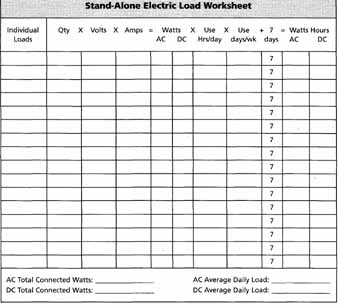
Sizing a Solar Electric System. (a) This table provides
typical wattage (power consumption) readings for major appliances and household electronics. (b) This table can be used to list all of your
appliances and to determine how much power they use each day.
Once you know how much electricity you consume, you need to run through some additional calculations. These are typically in a worksheet form. You can also complete this process using computer software.
The worksheets available through Solar Energy International’s book Photovoltaics: Design and Installation Manual, first allows you to determine electric load (demand for electricity) as just described. It then leads you through a few computations necessary to determine the size of the inverter you’ll need. After this, you determine the size of the battery bank you’ll need if you are designing an off-grid home, It then leads you through calculations to size the array that is, to determine the number of PV modules you’ll need. This calculation takes into account your demand, the efficiency of the entire sys tem, and solar availability.
If your eyes are starting to glaze over, don’t despair. A local installer can run the numbers for you. Even if you are planning on installing the system yourself, you might want to hire a local installer to consult with you at this stage. (Be careful, warns Weiss, if you install a system yourself. You’ll be dealing with high-voltage DC and AC current that can be dangerous!)
PV systems should be sized for the season with the highest energy demand and the lowest solar energy influx (insolation). You can determine this with a little simple math: simply divide each season’s electrical energy requirements by the corresponding insolation values.
Bear in mind that solar systems, like any energy systems, are not 100 percent efficient. That is, you won’t obtain 100 percent of the electricity solar electric panels generate. As a rule, you should size your system about 35 percent bigger than you’d expect to need based on electrical demand and solar modules production. This takes into account the efficiency losses of batteries and inverters, (Batteries give you only 70 percent of the electricity that goes into them and inverters lose about 5 to 10 percent of the energy flowing through them — it takes a little energy to convert DC to AC and to boost the voltage of electrical current in an inverter).
FYI: As a general rule of thumb, f your home is a normal, inefficient North American residence, you will need about two watts of solar electric power per square foot of home. If you are efficient, you could cut this by half. If you are super-efficient, you could cut this by half again.
Bear in mind that many people grossly underestimate how much electricity they and their families use. For instance, you might estimate that you run your TV only a few hours a night when, in reality, you and your family watch four hours per night on weeknights and eight hours per day on the weekends.
If you are feeling a bit dismayed, don’t be.
As noted earlier, solar installers (catalog suppliers and installers alike) provide work sheets, like the one shown above, that will make this process much easier. You can also find one in Solar Living Sourcebook and Solar Energy International’s Photovoltaics: Design and Installation Manual, an absolute must for those who are thinking of in staffing their own system. (You can learn more about them at SEI. Home Power magazine offers a free downloadable spreadsheet (called Energy Master) to analyze loads. Suppliers and installers will even lend you a hand with the process if you are buying a system from them.
If you are installing a solar electric system on an existing home for which you have electrical consumption data, use that information; it’s much more reliable than the guesswork required to size a system for a new home. But remember: reduce your demand first! Be sure to apply energy conservation measures vigorously before you estimate how much electricity you will be using. Again, solar suppliers and installers will help you size your system.
As a general rule of thumb, if your home is a normal, inefficient North American residence, you will need about two watts of solar electric power per square foot of home. If you are efficient, you could cut this by half. If you are super-efficient, you could cut this by half again.
This means that if your home is 2,000 square feet and you don’t practice energy conservation, you need a system whose capacity is about 4 kilowatts. This rating is determined by multiplying the number of square feet by the maximum output of the modules. In this instance, 2,000 square feet x 2 watts per square foot = 4,000 watts or 4 kilowatts). If the modules produce 100 watts each at peak power, you’ll need 40 of them. If they cost $500 each, your cost for PV modules will be $20,000. For stand-alone systems, you’ll also need batteries, which could run you $10,000, and an inverter, that might cost $3,000 to $4,000, and charge controllers and disconnects, which cost $600, and then there’s the installation cost of $4,000 to $6,000 or more, Your system could run you $42,000 to $45,000.
If your home is pretty efficient, however, you could get by with a two-kilowatt system, costing nearly half as much. If your home is super-efficient, you will need only a one-kilo watt system, costing one-fourth as much as the system you’d need if you hadn’t invested the time, energy, and money to make your home energy efficient.
Once you have sized your system, you will also need to determine the system volt age. As a general rule, most installations that require fewer than 2,000 watt-hours of electricity per day are designed as 12-volt systems, according to Storage Batteries for Renewable Energy Systems. The 2,000 to 6,000 watt-hour per day range is a gray zone, says Perez, but most are probably 24 volt. Over 6,000 to 8,000 watt-hour per day systems are 24 volt or higher (48 volt). SEI’S notes that “high-voltage systems are more desirable because they save on wire size, fuse, and circuit breaker size”.
Next: Buying a Solar Electric System
Prev: What is Passive Cooling?